Energy Management of a Multi-Source Vehicle by λ-Control
Abstract
:1. Introduction
2. Modelling and Control Organization
2.1. Architecture and System Modelling
2.2. Control Organization Using Energetic Macroscopic Representation
- -
- Four energy sources (green ovals) depict the three voltage sources (FC, SC, and Bat) and an equivalent current source (representing the electric load of the traction subsystem);
- -
- One coupling element (orange overlapping square) depicts the current node between the FC, the battery, the SC branches, and the DC bus (5);
- -
- The smoothing inductors store kinetic energy (2) and are accumulation elements (orange-barred rectangles) with the currents iLX as state variables, i.e., the outputs of the elements. The DC bus is also described as an accumulation element with the voltage ubus as the state variable (4);
- -
- The DC–DC converters are described by conversion elements (orange square) (3).
3. Real-Time Optimization-Based Strategy
3.1. Optimal Control and Control Organization
3.2. λ-Control Strategy
4. Validation of the Real-Time Optimization Based Strategy
4.1. Simulation Results
4.2. Experimental Validation
5. Conclusions
Author Contributions
Funding
Conflicts of Interest
Appendix A
| Pictogram | Element | Pictogram | Element | Pictogram | Element |
|---|---|---|---|---|---|
 | source element (energy source) |  | accumulation element (energy storage) |  | indirect inversion (closed-loop control) |
 | mono-physical conversion element |  | direct inversion (open-loop control) | ||
 | sensor mandatory optional |  | mono-physical coupling element (energy distribution) |  | coupling inversion (energy criteria) |
References
- Ehsani, M.; Gao, Y.; Emadi, A. Modern Electric, Hybrid Electric, and Fuel Cell Vehicles: Fundamentals, Theory, and Design, Second Edition; CRC Press: Boca Raton, FL, USA, 2009. [Google Scholar]
- Sharaf, O.Z.; Orhan, M.F. An overview of fuel cell technology: Fundamentals and applications. Renew. Sustain. Energy Rev. 2014, 32, 810–853. [Google Scholar] [CrossRef]
- Tang, Y.; Yuan, W.; Pan, M.; Wan, Z. Experimental investigation on the dynamic performance of a hybrid PEM fuel cell/battery system for lightweight electric vehicle application. Appl. Energy 2011, 88, 68–76. [Google Scholar] [CrossRef]
- Ball, M.; Weeda, M. The hydrogen economy—Vision or reality? 1. 1 This paper is also published as Chapter 11 The hydrogen economy—Vision or reality? In Compendium of Hydrogen Energy Volume 4: Hydrogen Use, Safety and the Hydrogen Economy; Ball, M., Basile, A., Veziroglu, T.N., Eds.; Elsevier: Amsterdam, The Netherlands, 2015. [Google Scholar] [CrossRef]
- Uddin, K.; Moore, A.D.; Barai, A.; Marco, J. The effects of high frequency current ripple on electric vehicle battery performance. Appl. Energy 2016, 178, 142–154. [Google Scholar] [CrossRef] [Green Version]
- Thounthong, P.; Raël, S.; Davat, B. Energy management of fuel cell/battery/supercapacitor hybrid power source for vehicle applications. J. Power Sources 2009, 193, 376–385. [Google Scholar] [CrossRef]
- Martinez, J.S.; Hissel, D.; Péra, M.-C.; Amiet, M. Practical Control Structure and Energy Management of a Testbed Hybrid Electric Vehicle. IEEE Trans. Veh. Technol. 2011, 60, 4139–4152. [Google Scholar] [CrossRef]
- Li, Q.; Chen, W.; Liu, Z.; Li, M.; Ma, L. Development of energy management system based on a power sharing strategy for a fuel cell-battery-supercapacitor hybrid tramway. J. Power Sources 2015, 279, 267–280. [Google Scholar] [CrossRef]
- Wirasingha, S.G.; Emadi, A. Classification and Review of Control Strategies for Plug-In Hybrid Electric Vehicles. IEEE Trans. Veh. Technol. 2011, 60, 111–122. [Google Scholar] [CrossRef]
- Yu, Z.; Zinger, D.; Bose, A. An innovative optimal power allocation strategy for fuel cell, battery and supercapacitor hybrid electric vehicle. J. Power Sources 2011, 196, 2351–2359. [Google Scholar] [CrossRef]
- García, P.; Torreglosa, J.P.; Fernández, L.M.; Jurado, F. Viability study of a FC-battery-SC tramway con-trolled by equivalent consumption minimization strategy. Int. J. Hydrogen Energy 2012, 37, 9368–9382. [Google Scholar] [CrossRef]
- Odeim, F.; Roes, J.; Heinzel, A. Power Management Optimization of a Fuel Cell/Battery/Supercapacitor Hybrid System for Transit Bus Applications. IEEE Trans. Veh. Technol. 2015, 65, 5783–5788. [Google Scholar] [CrossRef]
- Jiang, H.; Xu, L.; Li, J.; Hu, Z.; Ouyang, M. Energy management and component sizing for a fuel cell/battery/supercapacitor hybrid powertrain based on two-dimensional optimization algorithms. Energy 2019, 177, 386–396. [Google Scholar] [CrossRef]
- Sciarretta, A.; Back, M.; Guzzella, L. Optimal Control of Parallel Hybrid Electric Vehicles. IEEE Trans. Control. Syst. Technol. 2004, 12, 352–363. [Google Scholar] [CrossRef]
- Fu, Z.; Li, Z.; Si, P.; Tao, F. A hierarchical energy management strategy for fuel cell/battery/supercapacitor hybrid electric vehicles. Int. J. Hydrogen Energy 2019, 44, 22146–22159. [Google Scholar] [CrossRef]
- Kessels, J.T.B.A.; Koot, M.; Bosch, P.V.D.; Kok, D. Online Energy Management for Hybrid Electric Vehicles. IEEE Trans. Veh. Technol. 2008, 57, 3428–3440. [Google Scholar] [CrossRef]
- Kermani, S.; Delprat, S.; Guerra, T.M.; Trigui, R.; Jeanneret, B. Predictive energy management for hybrid vehicle. Control. Eng. Pr. 2012, 20, 408–420. [Google Scholar] [CrossRef]
- Onori, S.; Tribioli, L. Adaptive Pontryagin’s Minimum Principle supervisory controller design for the plug-in hybrid GM Chevrolet Volt. Appl. Energy 2015, 147, 224–234. [Google Scholar] [CrossRef]
- Ettihir, K.; Boulon, L.; Agbossou, K. Optimization-based energy management strategy for a fuel cell/battery hybrid power system. Appl. Energy 2016, 163, 142–153. [Google Scholar] [CrossRef]
- Bouscayrol, A.; Hautier, J.-P.; Lemaire-Semail, B. Graphic Formalisms for the Control of Multi-Physical Energetic Systems: COG and EMR. Syst. Des. Methodol. Electr. Energy Syst. 2013, 89–124. [Google Scholar] [CrossRef]
- Castaings, A.; Lhomme, W.; Trigui, R.; Bouscayrol, A. Gestion d’énergie par λ-control d’un véhicule multi-sources. In Proceedings of the Symposium de Genie Electrique, Grenoble, France, 7 September 2016. [Google Scholar]
- Amjadi, Z.; Williamson, S. Power-Electronics-Based Solutions for Plug-in Hybrid Electric Vehicle Energy Storage and Management Systems. IEEE Trans. Ind. Electron. 2009, 57, 608–616. [Google Scholar] [CrossRef]
- Li, Q.; Chen, W.; Li, Y.; Liu, S.; Huang, J. Energy management strategy for fuel cell/battery/ultracapacitor hybrid vehicle based on fuzzy logic. Int. J. Electr. Power Energy Syst. 2012, 43, 514–525. [Google Scholar] [CrossRef]
- Zandi, M.; Payman, A.; Davat, B.; Meibody-Tabar, F.; Martin, J.-P.; Pierfederici, S. Energy Management of a Fuel Cell/Supercapacitor/Battery Power Source for Electric Vehicular Applications. IEEE Trans. Veh. Technol. 2010, 60, 433–443. [Google Scholar] [CrossRef]
- Manoharan, Y.; Hosseini, S.E.; Butler, B.; Alzhahrani, H.; Senior, B.T.F.; Ashuri, T.; Krohn, J. Hydrogen Fuel Cell Vehicles; Current Status and Future Prospect. Appl. Sci. 2019, 9, 2296. [Google Scholar] [CrossRef] [Green Version]
- Boscaino, V.; Rizzo, R.; Miceli, R.; Galluzzo, G.R.; Capponi, G. Comparison of models of fuel cells based on experimental data for the design of power electronics systems. IET Renew. Power Gener. 2015, 9, 660–668. [Google Scholar] [CrossRef]
- Corbo, P.; Migliardini, F.; Veneri, O. Hydrogen Fuel Cells for Road Vehicles; Springer Science and Business Media LLC: Berlin, Germany, 2011. [Google Scholar]
- Blomgren, G.E. The Development and Future of Lithium Ion Batteries. J. Electrochem. Soc. 2016, 164, A5019–A5025. [Google Scholar] [CrossRef] [Green Version]
- Hellwig, C.; Sőrgel, S.; Bessler, W. A Multi-Scale Electrochemical and Thermal Model of a LiFePO4 Battery. ECS Trans. 2019, 35, 215–228. [Google Scholar] [CrossRef] [Green Version]
- Montaru, M.; Pelissier, S. Frequency and Temporal Identification of a Li-ion Polymer Battery Model Using Fractional Impedance. Oil Gas. Sci. Technol. Rev. L’Institut Français Pétrole 2009, 65, 67–78. [Google Scholar] [CrossRef]
- Zubieta, L.; Bonert, R. Characterization of double-layer capacitors for power electronics applications. IEEE Trans. Ind. Appl. 2000, 36, 199–205. [Google Scholar] [CrossRef] [Green Version]
- Delarue, P.; Bouscayrol, A.; Semail, E. Generic control method of multileg voltage-source-converters for fast practical implementation. IEEE Trans. Power Electron. 2003, 18, 517–526. [Google Scholar] [CrossRef]
- Horrein, L.; Bouscayrol, A.; Cheng, Y.; Dumand, C.; Colin, G.; Chamaillard, Y. Influence of the heating system on the fuel consumption of a hybrid electric vehicle. Energy Convers. Manag. 2016, 129, 250–261. [Google Scholar] [CrossRef]
- Rajabzadeh, M.; Bathaee, S.M.T.; Golkar, M.A. Dynamic modeling and nonlinear control of fuel cell vehicles with different hybrid power sources. Int. J. Hydrogen Energy 2016, 41, 3185–3198. [Google Scholar] [CrossRef]
- Castaings, A.; Lhomme, W.; Trigui, R.; Bouscayrol, A. Comparison of energy management strategies of a battery/supercapacitors system for electric vehicle under real-time constraints. Appl. Energy 2016, 163, 190–200. [Google Scholar] [CrossRef]
- Vinot, E.; Trigui, R. Optimal energy management of HEVs with hybrid storage system. Energy Convers. Manag. 2013, 76, 437–452. [Google Scholar] [CrossRef] [Green Version]
- Thounthong, P.; Davat, B.; Rael, S.; Sethakul, P. Fuel starvation. IEEE Ind. Appl. Mag. 2009, 15, 52–59. [Google Scholar] [CrossRef]
- Guzzella, L.; Sciarretta, A. Supervisory Control Algorithms. In Vehicle Propulsion Systems; Springer Science and Business Media LLC: Berlin, Germany, 2013; pp. 243–276. [Google Scholar]
- Kirk, D.E. Optimal Control Theory: An Introduction; Dover Publications: Mineola, NY, USA, 2004. [Google Scholar]
- Serrao, L.; Sciarretta, A.; Grondin, O.; Chasse, A.; Creff, Y.; Di Domenico, D.; Pognant-Gros, P.; Quérel, C.; Thibault, L. Open Issues in Supervisory Control of Hybrid Electric Vehicles: A Unified Approach Using Optimal Control Methods. Oil Gas. Sci. Technol. Rev. IFP 2013, 68, 23–33. [Google Scholar] [CrossRef] [Green Version]
- Dépature, C.; Lhomme, W.; Bouscayrol, A.; Sicard, P.; Boulon, L.; Jokela, T. Characterization of the electric drive of EV: On-road versus off-road method. IET Electr. Syst. Transp. 2017, 7, 215–222. [Google Scholar]
- Tutuianu, M.; Marotta, A.; Steven, H.; Ericsson, E.; Haniu, T.; Ichikawa, N.; Ishii, H. Development of a World-Wide Worldwide Harmonized Light Duty Driving Test Cycle (WLTC). UN/ECE/WP.29/GRPE/WLTP IG 2014. Available online: http://www.unece.org/fileadmin/DAM/trans/doc/2014/wp29grpe/GRPE-68-03e.pdf (accessed on 21 June 2020).
- Torokhti, A.; Howlett, P. Theory of Multiobjective Optimization; Elsevier: Amsterdam, The Netherlands, 1985. [Google Scholar]
- Barrade, P.; Rufer, A. Current capability and power density of supercapacitors: Con-siderations on energy efficiency. In Proceedings of the European Conference on Power Electronics and Applications (EPE) 2003, Toulouse, France, 2–4 September 2003. [Google Scholar]
- Omar, N.; Monem, M.A.; Firouz, Y.; Salminen, J.; Smekens, J.; Hegazy, O.; Gaulous, H.; Mulder, G.; Van den Bossche, P.; Coosemans, T.; et al. Lithium iron phosphate based battery—Assessment of the aging parameters and development of cycle life model. Appl. Energy 2014, 113, 1575–1585. [Google Scholar] [CrossRef]
- Bouscayrol, A. Hardware-in-the-Loop Simulation. In The Handbook of Optical Communication Networks; Informa UK Limited: Colchester, UK, 2011; pp. 1–15. [Google Scholar]
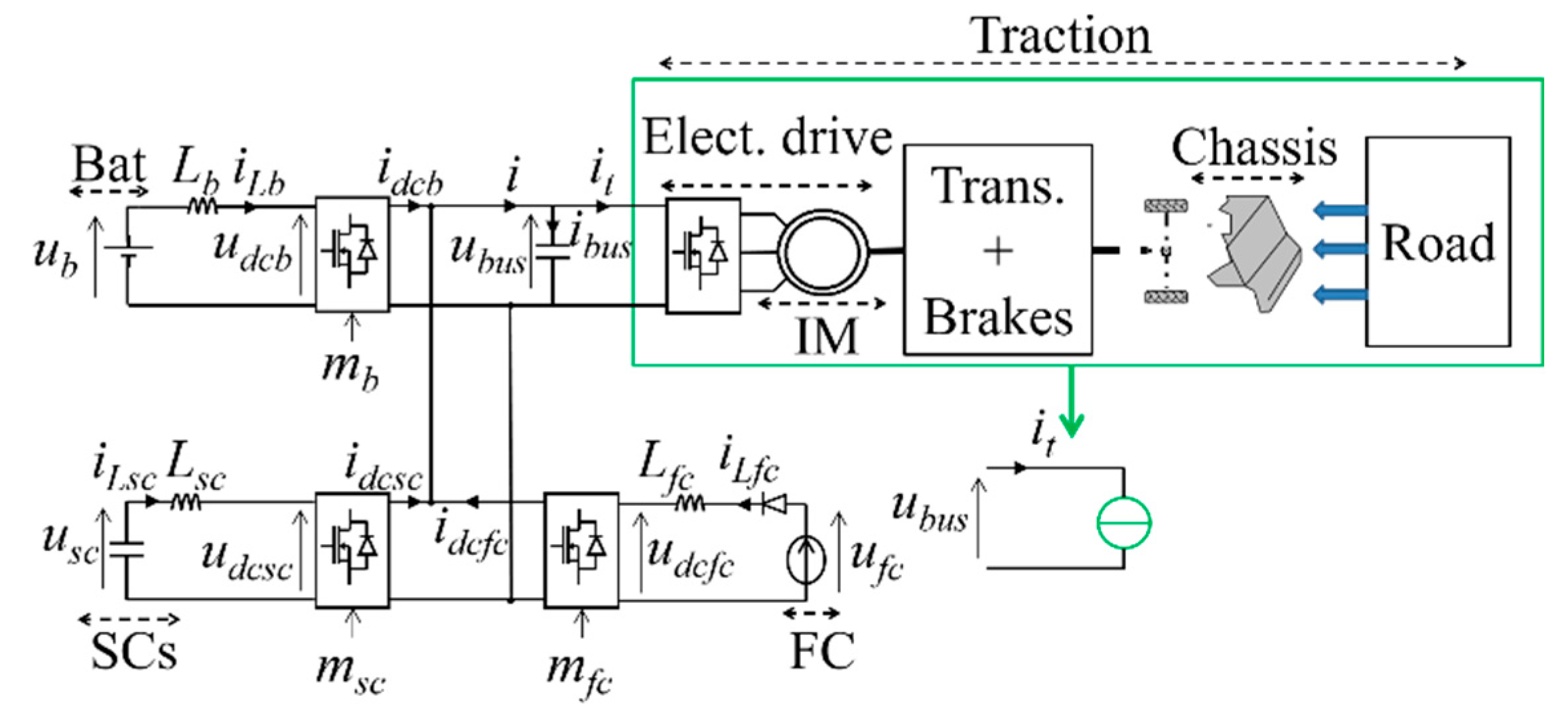

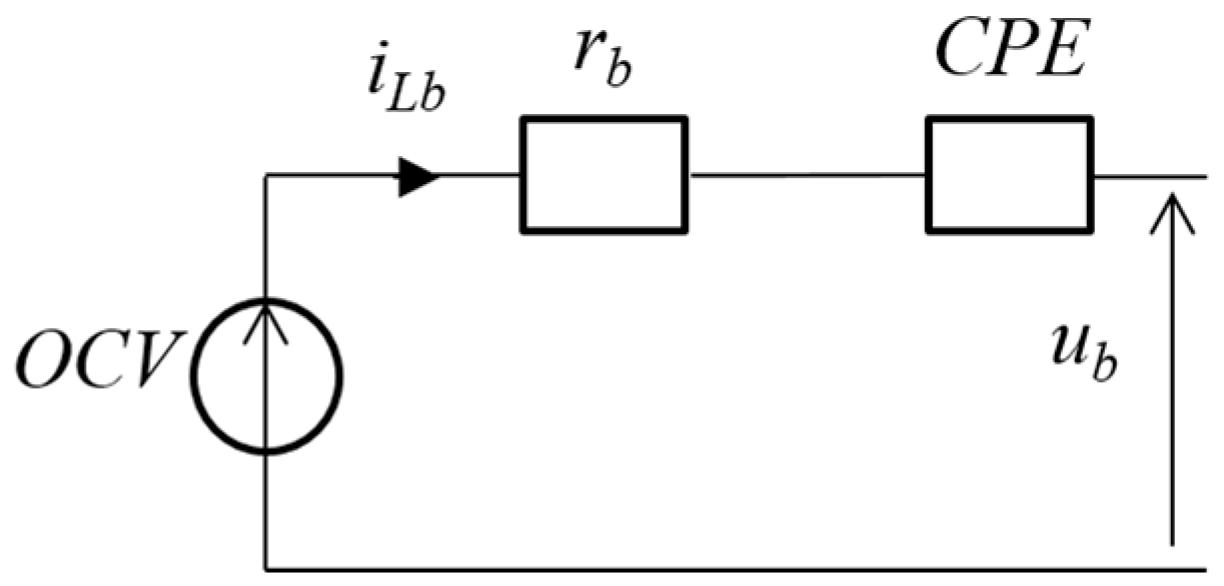


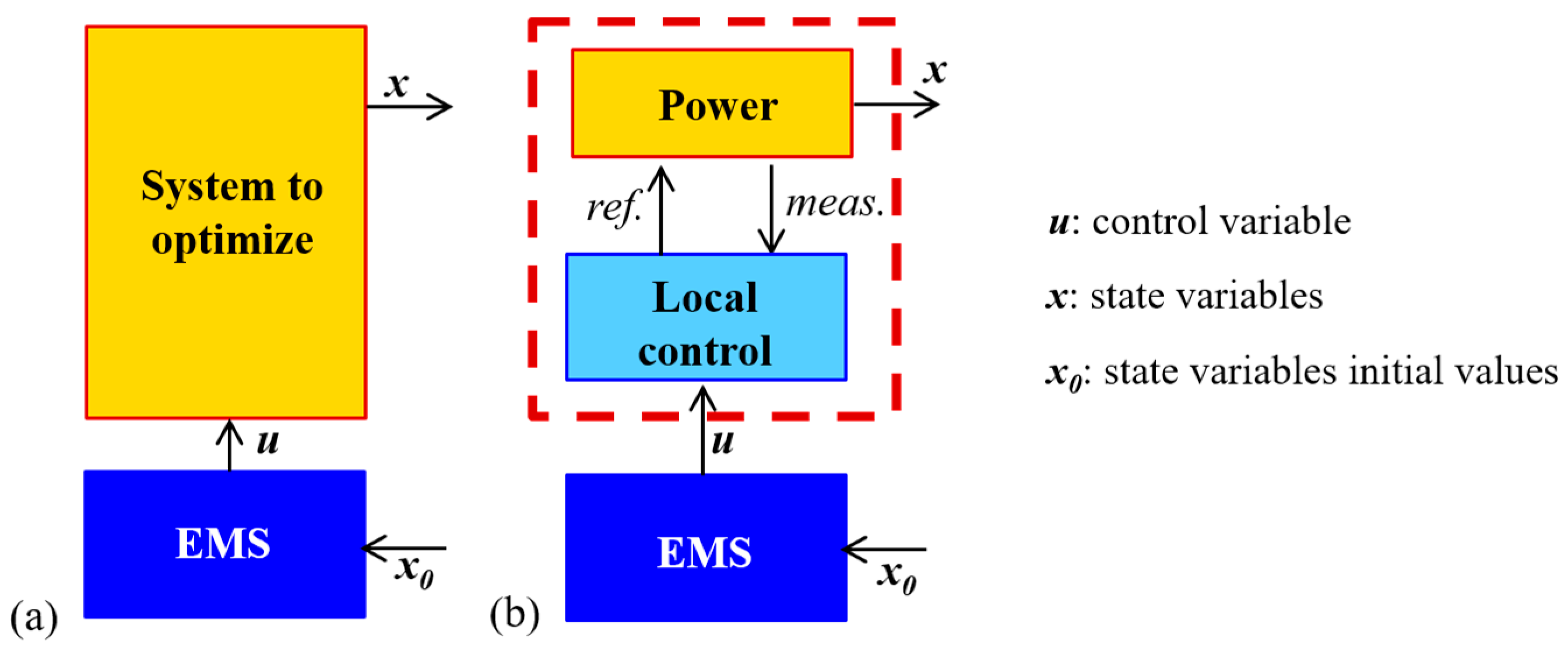
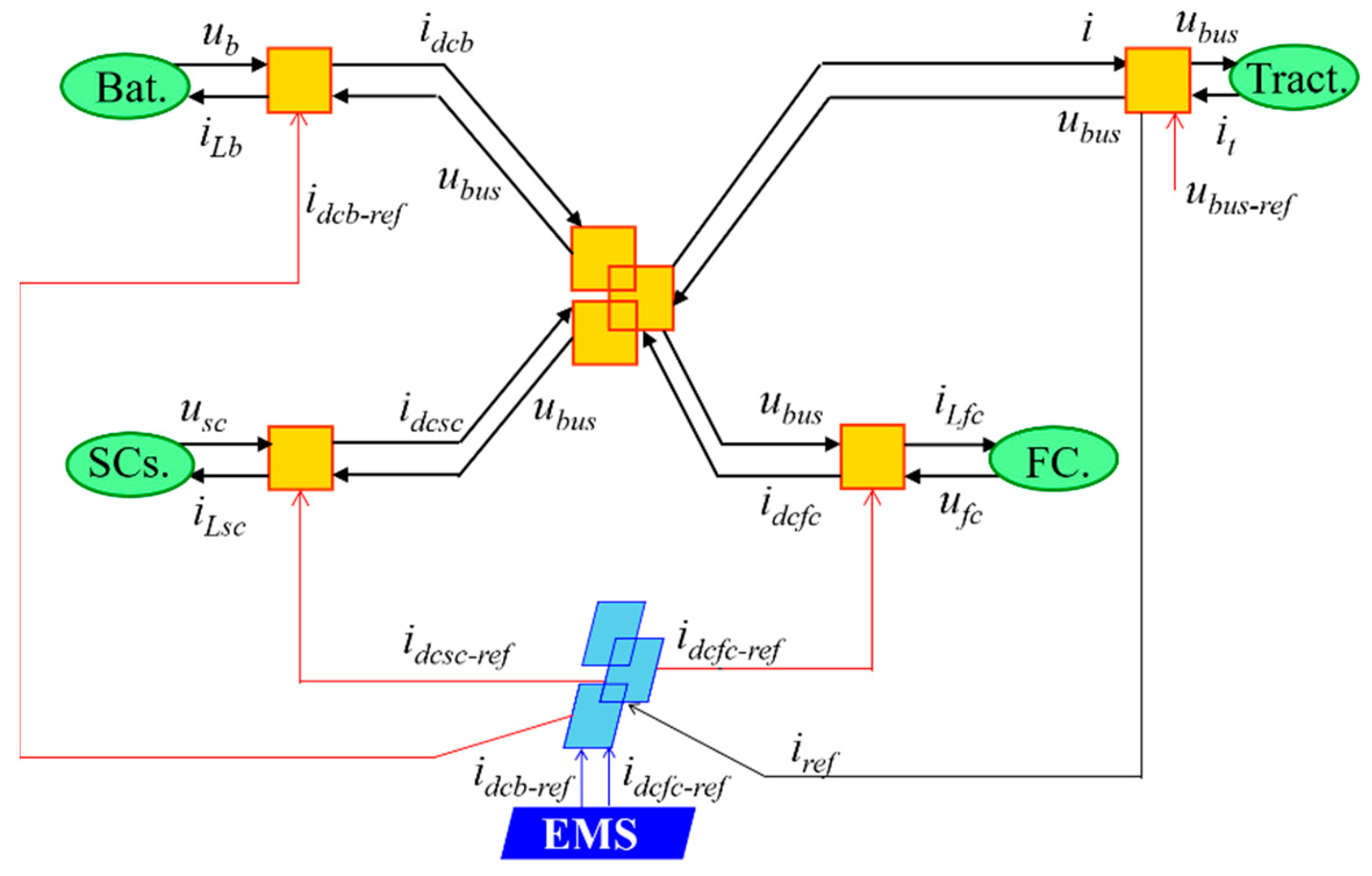

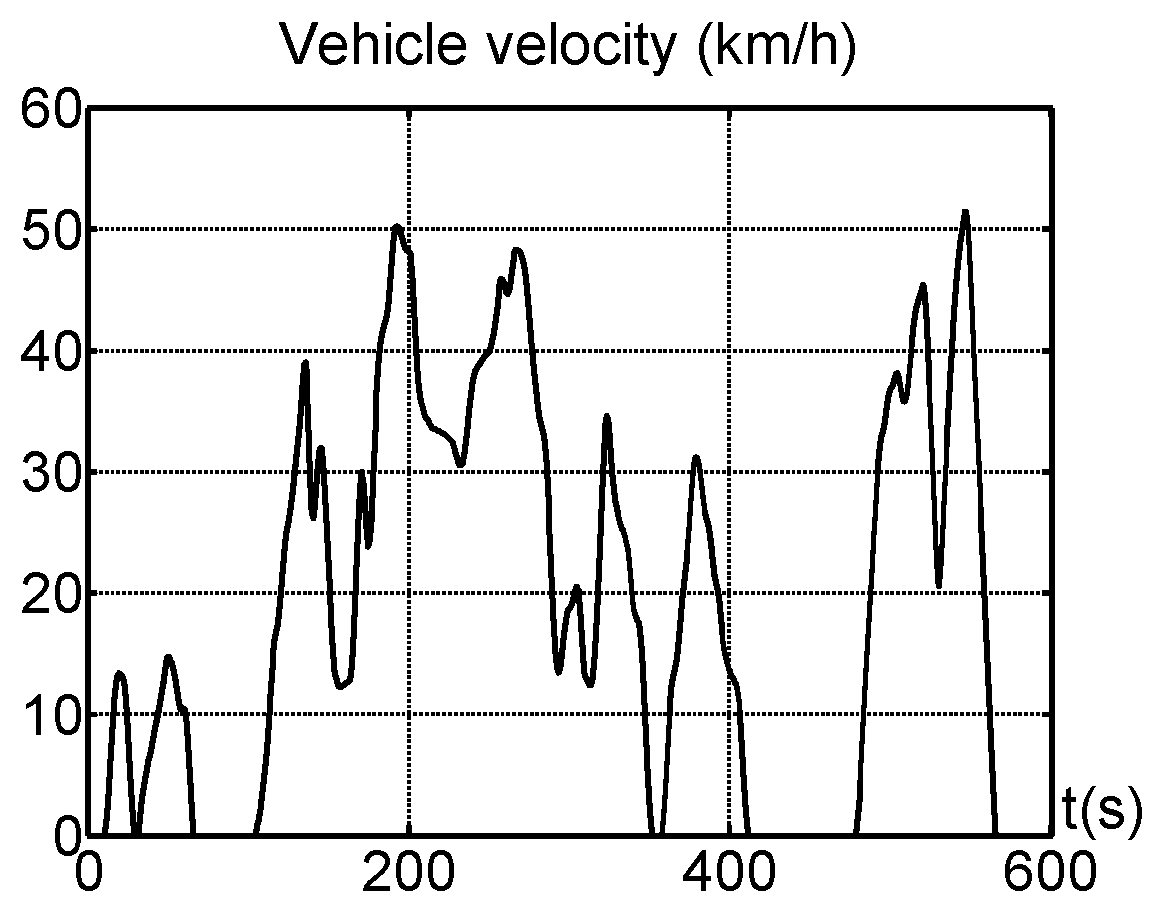
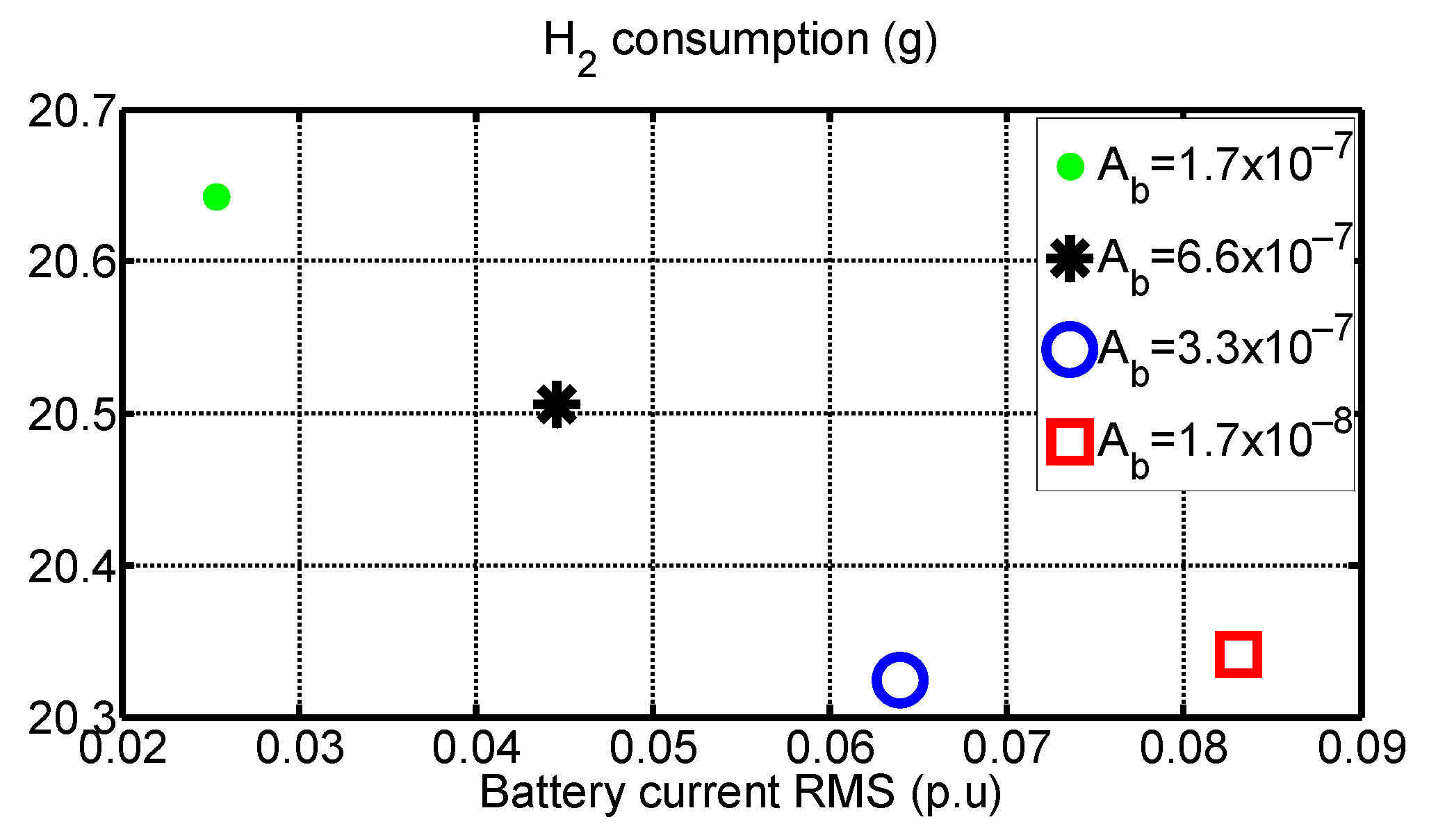
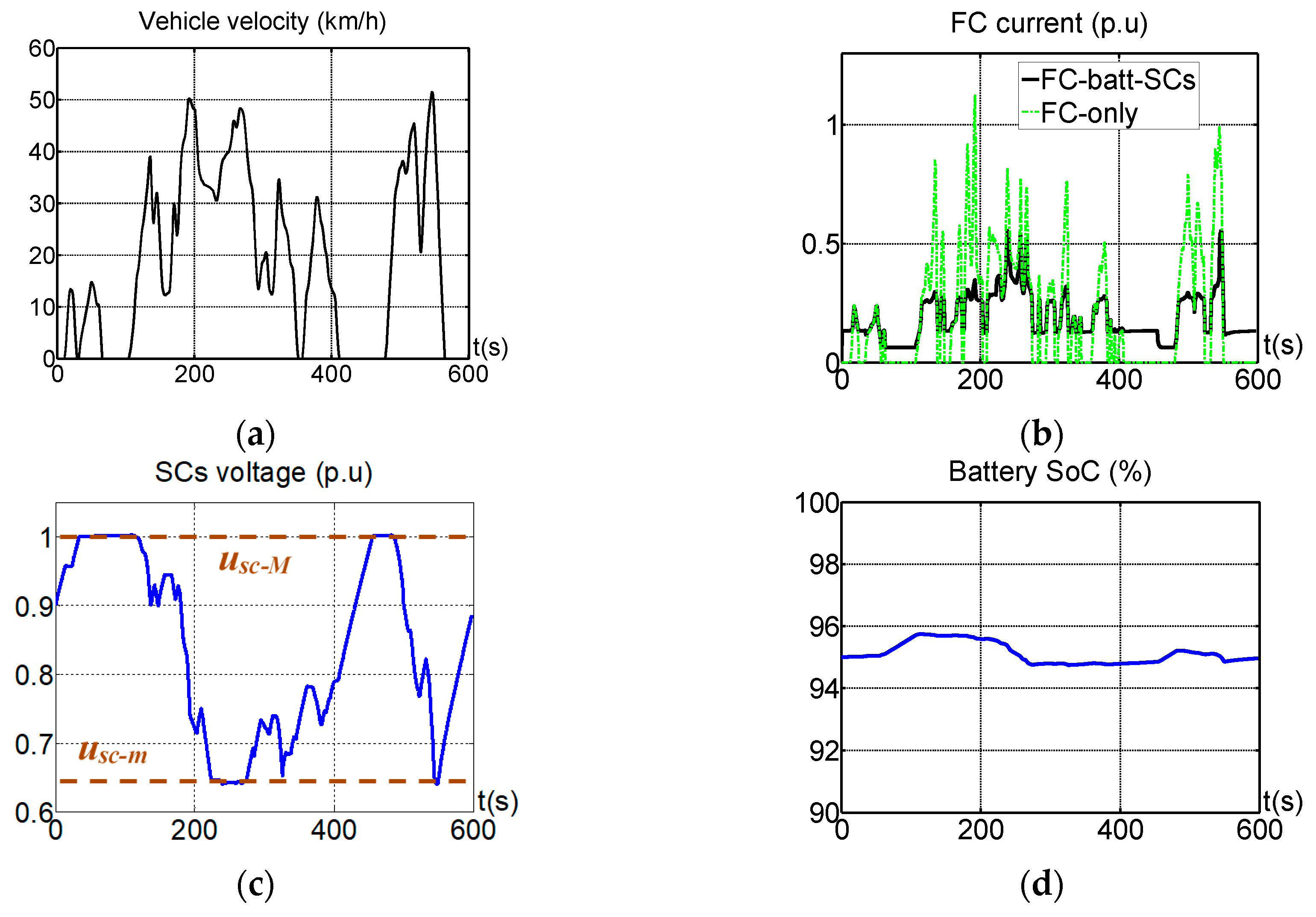

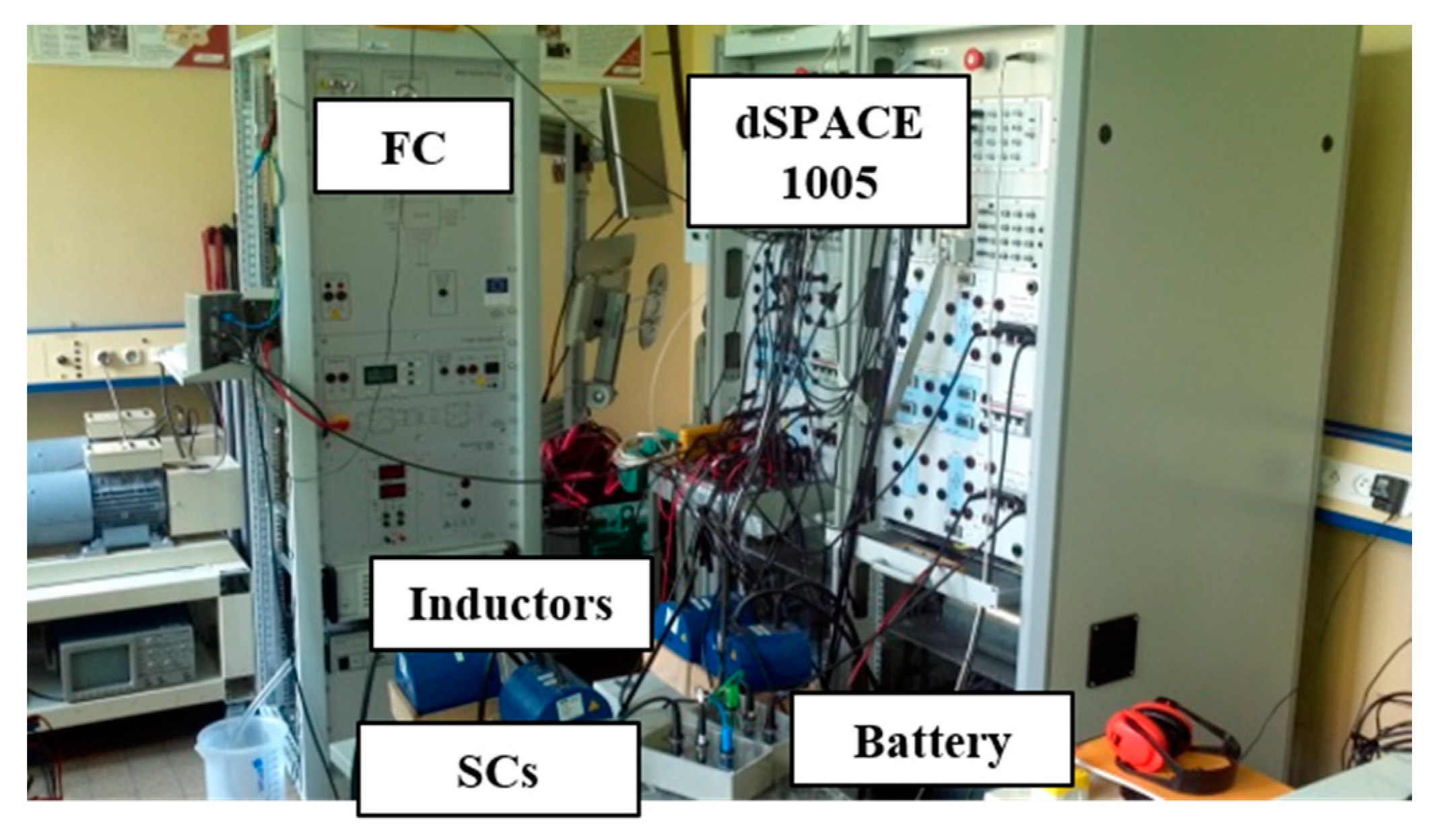


| Fuel Cell Stack | Type: PEMFC Maximal Power: 20 kW Voltage Range: 50–80 V |
|---|---|
| Vehicle | 640 kg |
| Electric drive | Rated power: 15 kW |
| Supercapacitor bank | usc-M = 45 V Csc = 290 F | rsc = 3.8 mΩ usc-m = 0.65 usc-M uSC-0 = 0.9 usc-M |
| Battery | 24 LFP cells (3.3 V/20 Ah) SoCb-M = 100% SoCb-m = 90% SoCb-0 = 95% |
© 2020 by the authors. Licensee MDPI, Basel, Switzerland. This article is an open access article distributed under the terms and conditions of the Creative Commons Attribution (CC BY) license (http://creativecommons.org/licenses/by/4.0/).
Share and Cite
Castaings, A.; Lhomme, W.; Trigui, R.; Bouscayrol, A. Energy Management of a Multi-Source Vehicle by λ-Control. Appl. Sci. 2020, 10, 6541. https://doi.org/10.3390/app10186541
Castaings A, Lhomme W, Trigui R, Bouscayrol A. Energy Management of a Multi-Source Vehicle by λ-Control. Applied Sciences. 2020; 10(18):6541. https://doi.org/10.3390/app10186541
Chicago/Turabian StyleCastaings, Ali, Walter Lhomme, Rochdi Trigui, and Alain Bouscayrol. 2020. "Energy Management of a Multi-Source Vehicle by λ-Control" Applied Sciences 10, no. 18: 6541. https://doi.org/10.3390/app10186541





